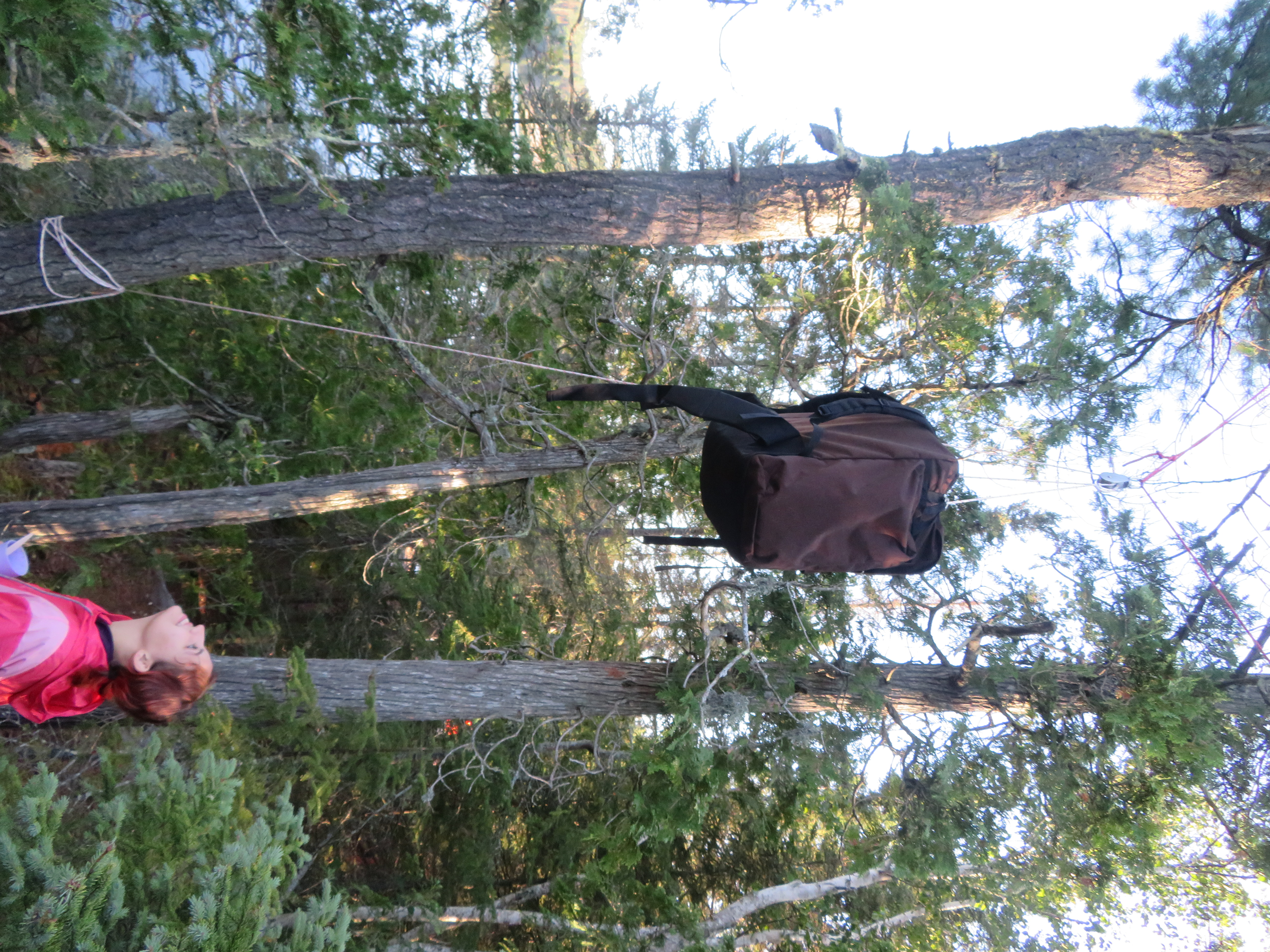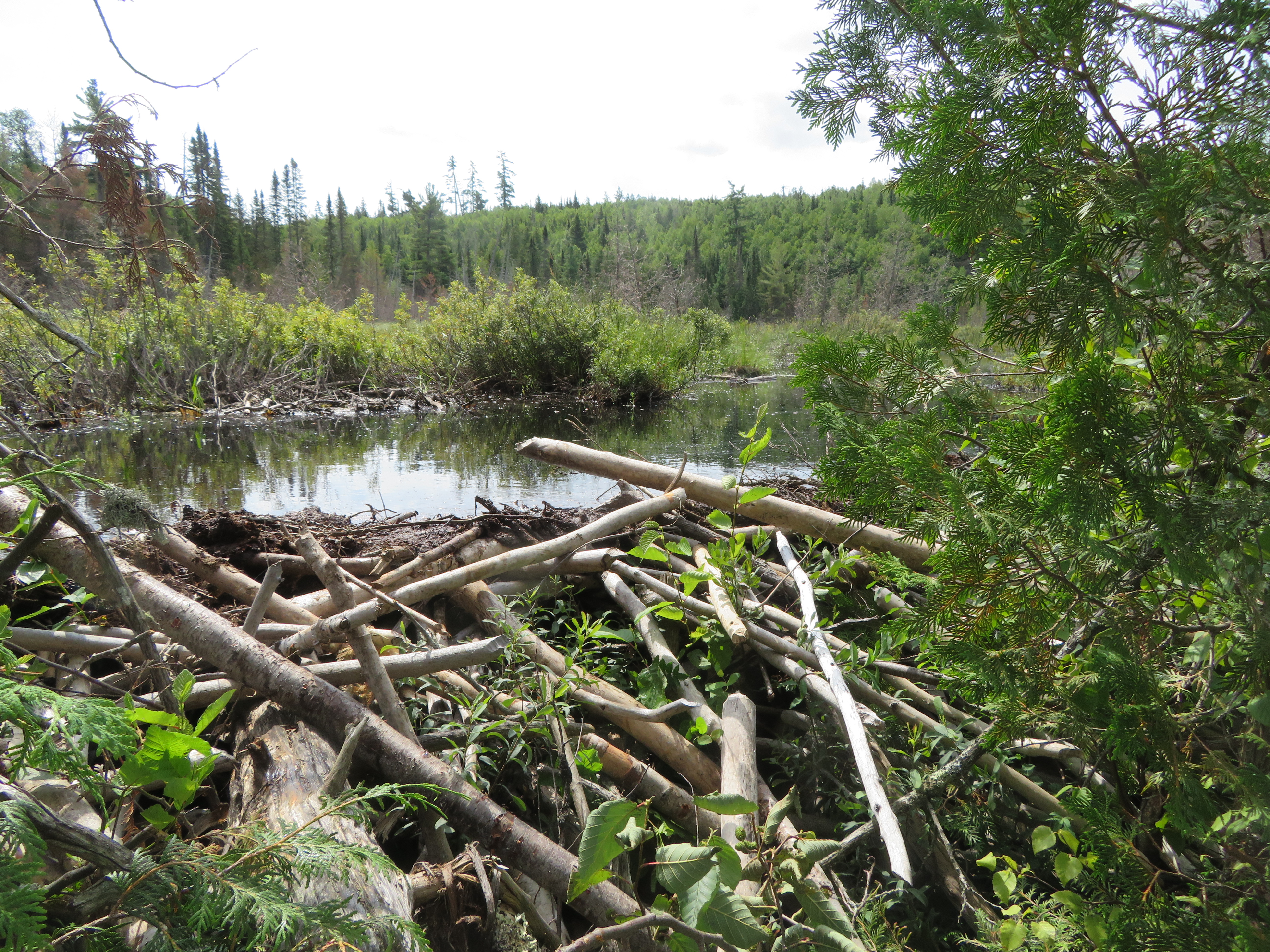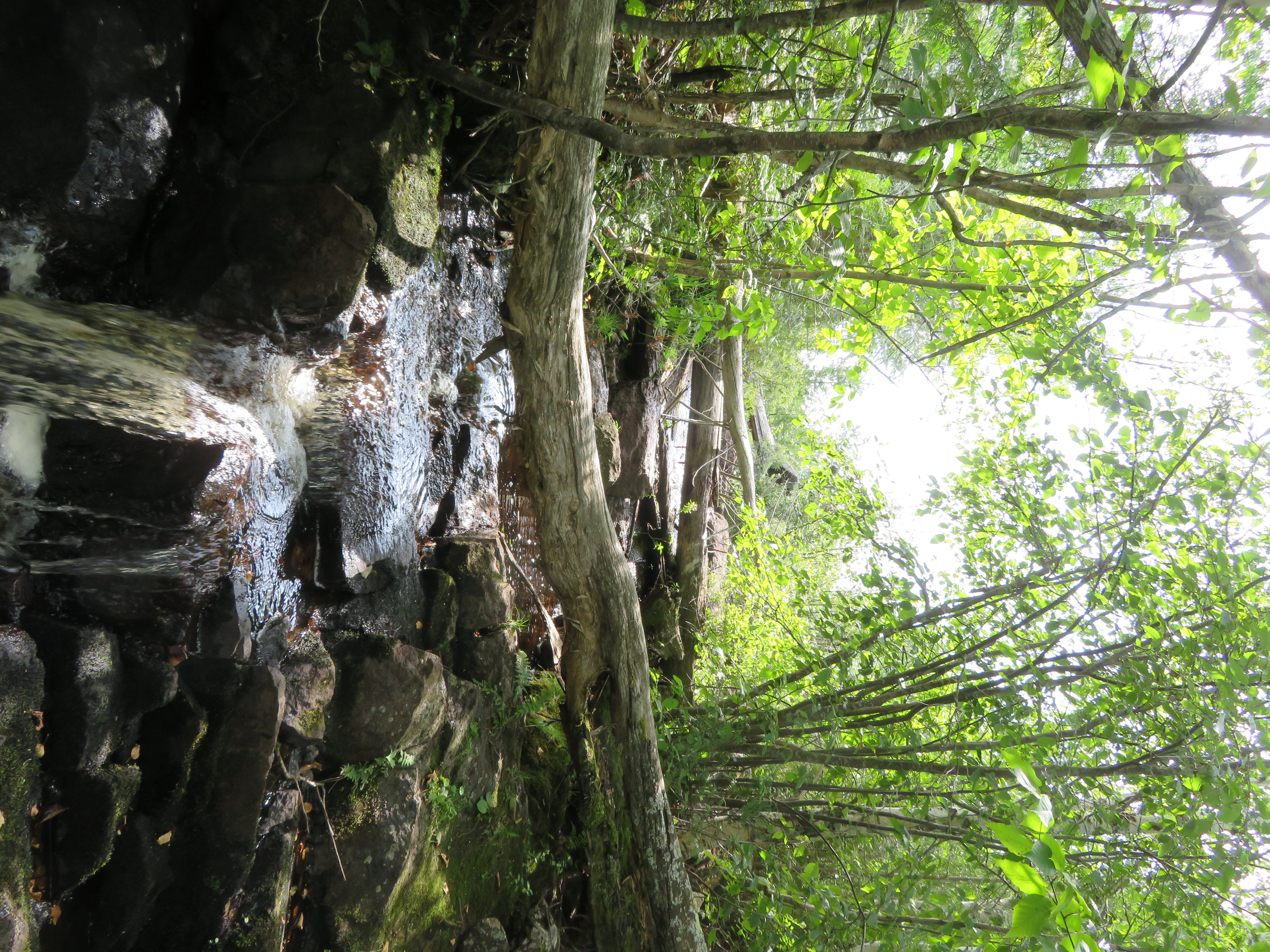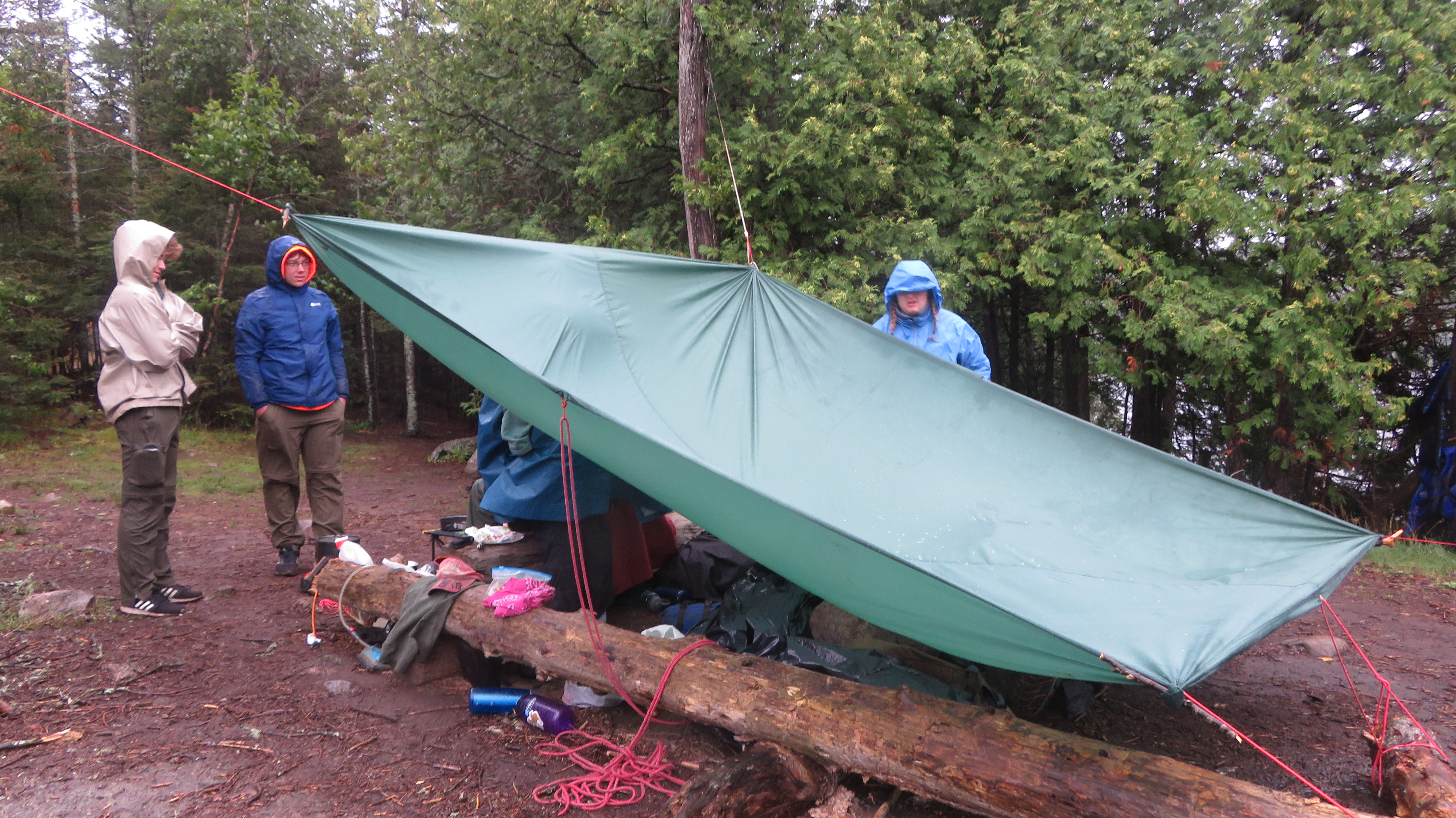Pushing Boundaries
Estimated reading time: .
After-action report on a trek in the Boundary Waters Canoe Area Wilderness.
ContentsOverview
My Scout troop likes to do a high adventure trek every year. Last year we went to the Florida Sea Base and did some sailing. This year, they elected to run a canoe trek in northern Minnesota’s Boundary Waters Canoe Area Wilderness, though not through the BSA’s own Northern Tier site, but rather go almost entirely on our own from an outfitter one of the troop families knows.
We had eleven youth, four other adults, and myself on the trip. We ranged from 14-19 in youth, and 31 (me) through… more than that… for the actual parents. Some of us had been canoeing regularly, and some had never been in one before. My job was to teach everyone enough canoeing to be useful, but I got to hand off planning and specialized skill transfer to Betty1, who’d been doing BWCAW trips for decades.
We did a nine-and-a-half day excursion, leaving our outfitter on Sunday, August 4th and returning on Tuesday, August 13th. The trek was, conveniently, divided roughly into three sections by our route and the weather. We also had to split into two crews of eight each.
This is an annotated map of the area.
Going Out
Day 1
We departed from the north shore of Poplar Lake, at Rockwood Lodge, and crossed to the southwestern portage (entry 48 on the map). This was 290 rods (4,790 feet, nearly a full mile) with completely full gear over heavy terrain. It was a brutal introduction. We had a pack for every person in the crew, plus a canoe per two people, and none of us were able to take both a pack and canoe at the same time, so four of us had to make a second trip.
- rod
- a canoe-length, or 16’6”
Upon landing in Meeds Lake, we crawled westwards for lunch at campsite 617, on an island roughly at its center. By this time we were into the afternoon, and completely exhausted, so after finding the next portage site we elected to just go back to 617 and set up camp for the night.
Day 2
In the morning, we woke up before our other half (who were camped at 615, west of us and closer to the portage) and made it to the portage ahead of them. As the portage trails are only one person wide, BWCAW etiquette is that once a trail is occupied, nobody else can use it until several minutes after the crew using it is completely out of sight, so we were locked into being ahead of them the rest of the day. Betty and her son, who had been doing this for most of his life, were in the other crew, so us being ahead of them was quite the morale boost.
We portaged to Swallow (104 rods, 1725 feet), crossed its sliver of water, then carried again to Pillsbery (90 rods, 1480 feet), canoed briefly west, and crossed to Henson Lake (51 rods, 850 feet). We finally had a long canoe westward across it, where we crossed into Omega Lake (31 rods, 510 feet).
 By this time, we were reaching physical exhaustion again; fatigue was causing us to stumble on the trail and become more irritable and stubborn. Four portages in, we traveled westward to campsite 592 for lunch. Our other crew elected to make one more portage, to Winchell Lake, and we considered following them before determining that we just didn’t have the physical capability.
By this time, we were reaching physical exhaustion again; fatigue was causing us to stumble on the trail and become more irritable and stubborn. Four portages in, we traveled westward to campsite 592 for lunch. Our other crew elected to make one more portage, to Winchell Lake, and we considered following them before determining that we just didn’t have the physical capability.
 Unlike yesterday’s campsite, this had a cliff and trees that let us set up our bear bags much more usefully. We strung one down the cliff face, were able to hand another high overhead by throwing from the clifftop over a tree below us, and our third bag was strung as best we could manage in the middle of camp.
Unlike yesterday’s campsite, this had a cliff and trees that let us set up our bear bags much more usefully. We strung one down the cliff face, were able to hand another high overhead by throwing from the clifftop over a tree below us, and our third bag was strung as best we could manage in the middle of camp.
Other than collecting some leeches, we had a fairly uneventful night.
Day 3
Four of the scouts wanted to make a day trip to Winchell Lake to find the other crew. I went with them, and we made the portage and worked our way along the north shoreline until we found them at camp 760. They reported that there was a very nice site (camp 762) which was occupied last night but now vacant, and we should move into it. We went back to our site on Omega, frantically packed up, and rushed to 762 as quickly as we could. The other crew, in a minor violation of good etiquette, had occupied it during the lunch travel window, preventing a handful of other parties from landing there, and so it was unoccupied when we arrived.
Site 762 is a west-facing spit that ramps gently down into the lake. It has an underwater shelf suitable for canoe landings, then a steep drop-off into clear, uninhabited, water. It has plenty of tent sites and bear-bag trees. It was a (nearly) perfect place for us to camp. We set up camp, then went to visit the other crew again, and together found a waterfall made by a beaver colony.


Let’s Talk About Bear Bags
Before I continue, Anna1 insists I relay what it takes to secure food in a wilderness area. Everything considered smellable goes in as few packs as possible, and then those packs need to be made inaccessible to the various animals that want to get in them: squirrels, bears, scouts at midnight, etc.
This is a fairly difficult process.
- Tie a lightweight paracord around a rock, and get it to stay attached to the rock. This is more difficult than you think.
- Get your star baseball player to throw the rock about twenty feet up, over a branch that looks like it can support a couple hundred foot-pounds of extra torque.
- Get the paracord stuck against the bark with the rock high out of reach. Whipping the loose end of the line around to dislodge it can get you a few feet of descent, but ultimately, it sticks in place, unmoving. Pulling the loose end brings the rock down out of the tree, wasting the throw.
- “Find” a “dead” juvenile tree, about twelve feet long, and fashion it into the worst possible sewing needle. Ask your Scoutmaster to snag the rock and pull it down to where we can use it.
- Break your only saw in two different places while prepping the definitely dead tree that you definitely found laying out on the ground, where it had been blown over by wind, or uprooted by animals that are definitely not human. Oops.
- Tie your heavy bag-hanging line to the paracord, then pull the rock so that the heavy line loops over the branch. Make an adjustable loop in the heavy line and attach your pulley.
- Start pulling the heavy line to raise the pulley.
- Realize you forgot to attach the second line through the pulley, which is now hanging high up in the air completely out of reach. Fortunately, you still have that tree that you for sure didn’t rip out of the ground fifteen minutes ago. Grab the pulley, bring it back down, thread it correctly this time, and try again.
- Okay. The pulley is up in the air. Adjust the two lines until you’re satisfied with where it hangs, far away from any tree, high enough up that a bear can’t stand up on two legs and swat the bag down.
- It could totally do that. Do you have any idea how big a bear is? And the only good trees are right next to some of our tents. Let’s be honest with ourselves. This is squirrel defense only.
- That was bag one. Do it all again for bag two.
- And for bag three. Well, this time the rock went over two branches instead of one. It’s swaying back and forth. We can pull it back, but you have to either wait for it to stop, or …okay, we’re going. Go fast! Commit! Don’t stop or it’ll whip itself completely around the branches and get…
- Stuck.
- Far too high for the tree-needle to do anything about it.
- Well, we’ve eaten a third of our food, which filled three bags. We could just hang two bags instead. That’ll be fine.
- Two days later, hear a creaking sound as the tied-together branches force themselves apart. Look up. DODGE THE ROCK!
Staying Put
We knew the weather was about to turn: a large cold front was headed our way, bringing persistent rain and winds for the next three days.
Day 4
 We had the morning to get ready for the rain to arrive, and spent it exploring our section of shoreline and stringing a tarp to serve as our windbreak and rain shelter.
We had the morning to get ready for the rain to arrive, and spent it exploring our section of shoreline and stringing a tarp to serve as our windbreak and rain shelter.
This is where the “nearly” part of the site’s perfection happens: it is a west-facing spit of rock looking out directly into the open lake. The wind blows smoothly and uninterruptedly down it, then scoops up the bare rock face and blasts directly into our firepit and tents.
That tarp, with its west end down as low as we could get it while keeping the east end high enough for me to stand below it, received horrible amounts of wind load. Translated to horizontal stress along the support wires, it was probably carrying several hundred pounds, and the grommets all tore out over the next few days.
The rain began in the evening.
Day 5
I taught Euchre. Anna taught Rummy. Tyler taught 31. We spent most of the day either in our tents or under the tarp, playing cards. Euchre and Rummy didn’t have stakes. For 31, we gambled our food.
Something I appreciate deeply about the Scouting ethos is that nobody even suggested that the winner would take the entire pot of food for themselves. Everyone at the table ate from the pot equally. The object of the game wasn’t to hoard the food; it was to force the other players to share their unique possessions. I had a particularly nice trail mix. Oscar had pistachios. Tyler had Swedish Fish.
Day 6
Temperature continued to fall. At this point, I am obligated to mention that I, being a strong believer in the virtues of boots over shoes, had brought my diving boots for wet-foot work and my (heavy, large) leather hiking boots for dry-foot. And during pack-up on night 0, I decided that my hiking boots were too large to make it in our packs, and left them behind.
I was barefoot the entire time we were at this site. I was also usually in shorts rather than long pants, since getting water required walking out to the edge of the shelf (knee-deep on me) and scooping lakewater into a bag for filtering. The water was warm, but the air was not, and most of the time, I wound up being the water fetcher. I will say the youth were gamely willing to go get it, but they didn’t love the experience, and I didn’t have dry shoes/socks to juggle, so,
We’d hoped we might leave today and make camp on Gaskin Lake, but the weather didn’t relent until far too late for us to leave.
We made our first real dinner, jambalaya.
Moving On
Day 7
Finally released from the rain and cold, we packed up and headed east across Winchell. By this time, we’d eaten enough food that we thought we could try to single-shot the portages: the three strongest youth and I would each carry a pack and a canoe at the same time, and the other four in the crew would carry a pack and our loose items (paddles, water bottles, broken fishing gear), and we’d eliminate the backtracking we hated in the first few days.
Winchell to Gaskin is a 45 rod (850 feet) portage over a severe elevation change. We lost circulation in our fingers by about rod 15. By the time we got to the (horrid) landing at Gaskin, our arms were completely disabled. Great concept, terrible execution.
The other crew had moved to Gaskin on day 4 and waited out the rain there. By the time we got to Gaskin, they’d also woken up and moved on, so they were about three miles or an hour ahead of us for the rest of the day. We worked east-northeast across Gaskin, and crossed to Horseshoe Lake (98 rods, 1620 feet). Horseshoe Lake is exactly what it sounds like: a long, U-shaped lake, with two east-west prongs joined on the eastern edge. We landed in the southern prong. The next portage was in the northern.
Thankfully, Horseshoe has very pretty shorelines to occupy our minds as we take an agonizingly circuitous route to our next goal.
The crossing to Caribou Lake is 22 rods (360 feet). We decide this is short enough to suck it up and one-shot, and it works. This is the easiest carry of the whole trip, both for length and terrain quality. We cross Caribou, see the other crew camped at site 641, and make camp ourselves at 643.
Winchell Lake spoiled us. Site 643 has silty water, biofilmed slippery rock, and only one good bag tree. But, the site itself is larger, the latrine is not a 5-minute walk into the forest, and our end is in sight.
Day 8
We spend today and tomorrow going back and forth with the other crew. We swim, play cards, attempt to find a small lake for scenery, fail, swim, stay up late, and watch the aurora. We even see the Perseid meteors and some Iridium flares.
Day 9
We make our last group meal, and realize we rationed a little too strictly on Winchell when we weren’t traveling and making ourselves hungry, so we eat as much as we can rather than pack it out.
We plan to wake up at, or before, dawn, to strike camp and get out. We also plan to stay up until midnight or later to catch the aurora again.
The aurora doesn’t show.
Coming Home
Surprisingly, we actually do wake up on time, strike camp, and start boarding.
In our first and only aquatic accident, we tip a boat. The other crew passes us while we reset, and so we dog their heels at the portage to Lizz Lake (68 rods, 1130 feet), race them across it, and arrive at our final portage back to Poplar at the same time…
that another group is exiting Poplar. We help them get launched, and then just make the portage as one large collective. We’re out of the federal BWCAW region, so the small-party restriction is gone. We make our way back north-northwest across Poplar to the outfitter.
There is no cell service in the boundary waters. I didn’t even bother bringing my phone, and left it in my car. During checkout, I turn it back on and start catching up on what I’ve missed. I get one very important email, which I’ll describe in the next section, and 230 pieces of garbage.
We drive to Grand Marais, get tourist trapped, head to Duluth, juggle car repairs and the hotel, shower, sleep, wake up, and drive home. We get reminded that we’ll arrive about two hours before a parade in our town, so we frantically determine who can show up for that and what we can do. We elect to portage two of Betty’s canoes as a statement about what we do for fun, and hand out recruitment flyers. It is a hit with the crowd, and we already have somebody expressing interest.
Scouting For All
My town has three Scout troops. One of them is very large, one of them is the right size, and the third has four youth.
I work with the latter two. They’re a boys-only and a girls-only unit… on paper. In practice, they function just like Venture crews have for decades: coëd, integrated, and without incident.
A month ago, our Council informed us that there was a pilot program starting up for troops that had been de facto integrated to become integrated de jure, and asked us if we would like to do that. We, of course, jumped at the chance.
When I got out of the lake and turned on my phone, I received an email from Council stating that we are in the first cohort of fully integrated Scout troops in the nation. No more pretense, no more separate-units coïncidentally sharing a charter and equipment supply, and crucially, no more requirement that we have five girls to maintain their troop. This matters a lot, because we currently have exactly five, and one of them turned eighteen this year, dropping us down to four by the time of recharter, and troops can’t charter with four.
But there isn’t a girls-only troop in my town anymore. There’s a four-scout patrol of girls in my integrated troop, which isn’t ideal, but we can work on it.
I never really gave integration much thought when I was in Scouts as a youth. It just wasn’t a topic at hand. But when I started working at summer camp as a 19-year-old, the reality came crashing down on me: our stupid policies about restricting queer boys and all women (a) weren’t preventing sexual impropriety, obviously, and (b) were drastically reducing how many people could, or would, show up to the program.
The most enthusiastic, capable, and driven Scouters I have ever met have been universally those barred from the program. The women I’ve known on staff are smart and competent and bring skills that boys should have, but usually don’t. My camp was so much better for having them.
I’ve known troops with boys who are there by obligation. You can lead a horse to water, as the saying goes. They drag their feet. They don’t care. They don’t want to be there. And you cannot make them.
The girls in my troop are here because they want to be. They’re hungry. They’re brilliant, motivated, and unfortunately, a little bit spiteful. They’ve been here since the first whisper of possibility in 2019, and we have not done right by them, as an organization.
They’ve experienced harassment and discrimination from the people who are supposed to be their brothers and mentors and protectors. People who pledge every day to be trustworthy, helpful, friendly, courteous, kind, cheerful, and clean instead lie to them, interfere with them, degrade them.
And they keep showing up anyway.
These are the people I want in Scouting. These are the people who are going to — who have been — making Scouting better, making it fulfill its promise.
I am proud beyond words to know them. I am delighted that the boys in my troop accept them and work with them easily. I am thankful that the hardest work of integration was done before I even moved here. I am humbled that it even had to be done, and that I’d ever in my Scouting career been blind to attitudes that made it necessary. And most of all, I am profoundly honored that they chose me as their Scoutmaster, that they trust me to work with them and adventure with them and stand for them against anyone who somehow still thinks that the quality of a person is gated on a coin-toss of birth.
We are one society. We are one community. We are one World Organization of the Scout Movement.
And we are one troop!
- ↩
I am, of course, not using anyone’s real names.